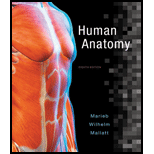
Human Anatomy (8th Edition)
8th Edition
ISBN: 9780134243818
Author: Elaine N. Marieb, Patricia Brady Wilhelm, Jon B. Mallatt
Publisher: PEARSON
expand_more
expand_more
format_list_bulleted
Concept explainers
Question
Chapter 21, Problem 5RQ
Summary Introduction
To determine:
The characteristics of the red pulp of the spleen.
Introduction:
The spleen is a soft blood-rich lymphoid organ that lies posterior to the stomach. It is the largest organ of the lymphatic system and it regulates the body fluid balance. The spleen plays a major role in immune functions as it stores white blood cells as well as thrombocytes. It contains two forms of tissues, namely the red and white pulp spleen tissues.
Expert Solution & Answer
Want to see the full answer?
Check out a sample textbook solution
Students have asked these similar questions
Describe the principle of homeostasis.
Explain how the hormones of the glands listed below travel around the body to target organs and tissues :
Pituitary gland
Hypothalamus
Thyroid
Parathyroid
Adrenal
Pineal
Pancreas(islets of langerhans)
Gonads (testes and ovaries)
Placenta
What are the functions of the hormones produced in the glands listed below:
Pituitary gland
Hypothalamus
Thyroid
Parathyroid
Adrenal
Pineal
Pancreas(islets of langerhans)
Gonads (testes and ovaries)
Placenta
Chapter 21 Solutions
Human Anatomy (8th Edition)
Ch. 21 - Prob. 1CYUCh. 21 - A sentinel lymph node is the first lymph node to...Ch. 21 - Fatty lymph, picked up by the lacteals in the...Ch. 21 - Prob. 4CYUCh. 21 - Prob. 5CYUCh. 21 - Prob. 6CYUCh. 21 - Prob. 7CYUCh. 21 - Prob. 8CYUCh. 21 - Prob. 9CYUCh. 21 - Prob. 10CYU
Ch. 21 - Prob. 11CYUCh. 21 - Lymphatic capillaries (a) are open-ended like...Ch. 21 - The basic structural framework of most lymphoid...Ch. 21 - Prob. 3RQCh. 21 - Prob. 4RQCh. 21 - Prob. 5RQCh. 21 - Prob. 6RQCh. 21 - Which of the following lymphoid organs have a...Ch. 21 - Which one of the following lymphoid organs does...Ch. 21 - Developmentally, the embryonic lymphatic vessels...Ch. 21 - It sometimes is difficult to distinguish the...Ch. 21 - In some people, the thoracic duct does not receive...Ch. 21 - Prob. 12RQCh. 21 - Prob. 13RQCh. 21 - Prob. 14RQCh. 21 - Prob. 15RQCh. 21 - Prob. 16RQCh. 21 - Prob. 17RQCh. 21 - As George was reading this chapter for the second...Ch. 21 - Prob. 19RQCh. 21 - Prob. 20RQCh. 21 - Prob. 1CRCAQCh. 21 - Prob. 2CRCAQCh. 21 - Prob. 3CRCAQCh. 21 - Mrs. Roselli has undergone a left radical...Ch. 21 - Prob. 5CRCAQCh. 21 - Simi realized she was very ill. During a recent...
Knowledge Booster
Learn more about
Need a deep-dive on the concept behind this application? Look no further. Learn more about this topic, biology and related others by exploring similar questions and additional content below.Similar questions
- Describe the hormones produced in the glands listed below: Pituitary gland Hypothalamus Thyroid Parathyroid Adrenal Pineal Pancreas(islets of langerhans) Gonads (testes and ovaries) Placentaarrow_forwardPlease help me calculate drug dosage from the following information: Patient weight: 35 pounds, so 15.9 kilograms (got this by dividing 35 pounds by 2.2 kilograms) Drug dose: 0.05mg/kg Drug concentration: 2mg/mLarrow_forwardA 25-year-old woman presents to the emergency department with a 2-day history of fever, chills, severe headache, and confusion. She recently returned from a trip to sub-Saharan Africa, where she did not take malaria prophylaxis. On examination, she is febrile (39.8°C/103.6°F) and hypotensive. Laboratory studies reveal hemoglobin of 8.0 g/dL, platelet count of 50,000/μL, and evidence of hemoglobinuria. A peripheral blood smear shows ring forms and banana-shaped gametocytes. Which of the following Plasmodium species is most likely responsible for her severe symptoms? A. Plasmodium vivax B. Plasmodium ovale C. Plasmodium malariae D. Plasmodium falciparumarrow_forward
- please fill in missing parts , thank youarrow_forwardplease draw in the answers, thank youarrow_forwarda. On this first grid, assume that the DNA and RNA templates are read left to right. DNA DNA mRNA codon tRNA anticodon polypeptide _strand strand C с A T G A U G C A TRP b. Now do this AGAIN assuming that the DNA and RNA templates are read right to left. DNA DNA strand strand C mRNA codon tRNA anticodon polypeptide 0 A T G A U G с A TRParrow_forward
arrow_back_ios
SEE MORE QUESTIONS
arrow_forward_ios
Recommended textbooks for you
 Biology (MindTap Course List)BiologyISBN:9781337392938Author:Eldra Solomon, Charles Martin, Diana W. Martin, Linda R. BergPublisher:Cengage Learning
Biology (MindTap Course List)BiologyISBN:9781337392938Author:Eldra Solomon, Charles Martin, Diana W. Martin, Linda R. BergPublisher:Cengage Learning Medical Terminology for Health Professions, Spira...Health & NutritionISBN:9781305634350Author:Ann Ehrlich, Carol L. Schroeder, Laura Ehrlich, Katrina A. SchroederPublisher:Cengage Learning
Medical Terminology for Health Professions, Spira...Health & NutritionISBN:9781305634350Author:Ann Ehrlich, Carol L. Schroeder, Laura Ehrlich, Katrina A. SchroederPublisher:Cengage Learning





Biology (MindTap Course List)
Biology
ISBN:9781337392938
Author:Eldra Solomon, Charles Martin, Diana W. Martin, Linda R. Berg
Publisher:Cengage Learning

Medical Terminology for Health Professions, Spira...
Health & Nutrition
ISBN:9781305634350
Author:Ann Ehrlich, Carol L. Schroeder, Laura Ehrlich, Katrina A. Schroeder
Publisher:Cengage Learning